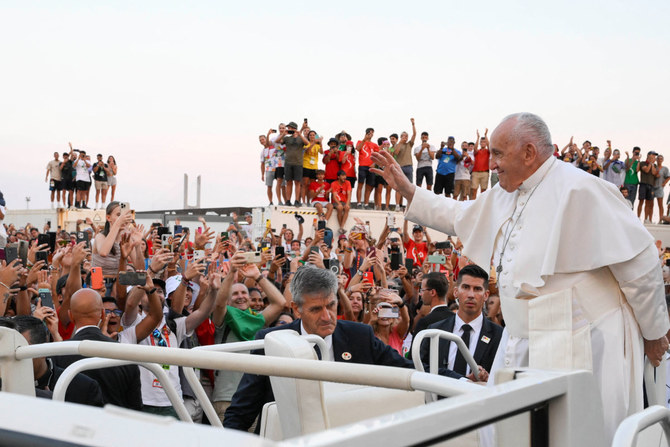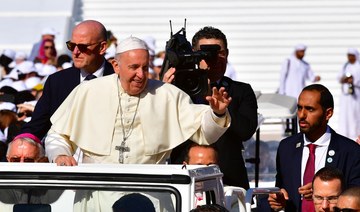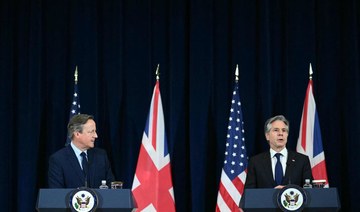LISBON, Portugal: An estimated 1.5 million young people filled a field in the Portuguese capital Lisbon on Saturday for Pope Francis’ World Youth Day vigil, braving scorching heat to secure a spot for the evening prayer and to camp out overnight for his final farewell Mass on Sunday morning.
Francis made only brief remarks before them, however, and ditched his prepared speech for the fourth time in two days. Instead, the 86-year-old pontiff delivered a lively, 10-minute off-the-cuff chat in his native Spanish about journeying together and helping one another. “No fear, thanks, ciao!” he said at the end before aides pushed him in his wheelchair to the side of the stage.
Temperatures had soared to 38 Celsius (95 Fahrenheit) on Saturday in Lisbon and were forecast to top 40 C (104 F) on Sunday. The heat forced pilgrims to shelter under umbrellas and makeshift shades of plastic canvas sheets tied between trash bins in the otherwise exposed field on the edge of the River Tagus.
Crews blew misters at the pilgrims to try to cool them down as they made their way into the venue at the peak of the day’s heat, many flying their national flags. They formed long lines to fill water bottles from what organizers said were more than 400 faucets around the field.
Smoke from a spate of wildfires that broke out around Portugal during a weekend spike in temperatures cast a haze over the sky as they arrived on foot from all around the city for one of the liturgical highlights of the Catholic youth festival. Citing local organizers, the Vatican said an estimated 1.5 million people were on hand.
Lan Young Modesta Cheong, a pilgrim from South Korea, said the heat was bad but her group made use of the trash bins to create shade.
“At first we were not so comfortable with it because is dirty and it maybe smelly but at a certain point it became our tent, it’s kind of a miracle and for me it is a bit the spirit of World Youth Day,” she said. “We started using a useless dirty thing to support us and use it to avoid the heat and all these difficulties.”
Francis presided over the evening vigil after spending the morning at the Catholic shrine in Fatima.
There, he ditched his prepared speech and a prayer for peace. The prayer had been expected to be a highlight of Francis’ visit to Fatima, given the shrine’s century-old affiliation with exhortations of peace and conversion in Russia and the ongoing war in Ukraine.
Francis instead “prayed silently for peace, with pain,” while meditating for a long period before a statue of the Virgin Mary, Vatican spokesman Matteo Bruni said. And the Vatican later posted the prayer on the platform X, formerly known as Twitter.
An estimated 200,000 turned out for Francis’ visit to Fatima, packing the central esplanade long before the red-tinted moon set and the sun rose. Nearby wildfires turned the sky smoky black and sent ash snowing down on the crowd.
“We are here with great joy,” said Maria Florido, a 24-year-old Spaniard who also saw Francis in Lisbon. “We woke up very early to come here and see the pope ... and we’re here with great enthusiasm.”
The Fatima story dates back to 1917, when according to tradition, Portuguese siblings Francisco and Jacinta Marto and their cousin Lucia said the Virgin Mary appeared to them six times and confided to them three secrets. The first two described an apocalyptic image of hell, foretold the end of World War I and the start of World War II, and portended the rise and fall of Soviet communism.
In 2000, the Vatican disclosed the long-awaited third secret, describing it as foretelling the May 13, 1981, assassination attempt against St. John Paul II in St. Peter’s Square, which fell on the anniversary of the original vision.
According to later writings by Lucia, who became a nun and died in 2005, Russia would be converted and peace would reign if the pope and all the bishops of the world consecrated Russia to the “Immaculate Heart of Mary.” Lucia later claimed that John Paul fulfilled that prophecy during a 1984 Mass, even though he never specified Russia in the prayer.
Vatican Media had said before the trip that Francis would pray for peace in Ukraine and the world while in Fatima. It seemed logical, given Francis had already consecrated both Russia and Ukraine to Mary in a prayer for peace following Russia’s invasion of Ukraine, essentially fulfilling Sr. Lucia’s exhortation.
In the prayer posted on the platform X by the @Pontifex account but not read aloud, Francis didn’t name either country but consecrated the church and world, “especially those countries at war,” to Mary. “Open paths where it seems that none exist,” he wrote. “Loosen the tangles of self-centeredness and the snares of power.”
Fatima Bishop Jose Ornelas made a prayer for Ukraine explicit in his remarks. “We associate ourselves to Your Holiness’ prayer for peace, for which this sanctuary is profoundly identified, thinking in particular of the war in Ukraine and so many other conflicts in the world,” he said.
In explaining the changes, Vatican spokesman Bruni said Francis “always addresses firstly the people he meets, as a shepherd, and speaks accordingly.” Francis often deviates from his prepared remarks, even more when speaking in his native Spanish. Bruni denied the changes had any other serious reason, including with his eyesight.
Francis has been hospitalized twice this year, including in June when he spent nine days in the hospital recovering from abdominal surgery to repair a hernia and remove scar tissue on his intestine. Saturday was perhaps the most grueling day of his five-day visit to Portugal, given the round-trip helicopter ride to Fatima and a planned prayer vigil that didn’t begin until his usual bedtime in Rome.
1.5 million brave scorching heat for Pope Francis’ World Youth Day vigil in Portugal
https://arab.news/wdvsh
1.5 million brave scorching heat for Pope Francis’ World Youth Day vigil in Portugal

- Pope to wind up Portugal visit with big outdoor mass
- Temperatures had soared to 38 Celsius on Saturday in Lisbon and were forecast to top 40 C on Sunday
OIC calls for immediate aid amid Afghan flood crisis

- Flash floods from seasonal rains in Baghlan province in northern Afghanistan
RIYADH: The Organization of Islamic Cooperation has issued an urgent appeal to its member states as well as relief organizations to provide aid to the Afghan people amid catastrophic flooding which has hit the country, Saudi Press Agency reported on Sunday.
Flash floods from seasonal rains in Baghlan province in northern Afghanistan killed at least 315 people since striking on Friday, a UN report said.
Rains also caused heavy damage in northeastern Badakhshan province and central Ghor province, officials said.
Since mid-April, floods have left about 100 people dead in 10 of Afghanistan’s provinces, with no region entirely spared, according to authorities.
Farmland has been swamped in a country where 80 percent of the more than 40 million people depend on agriculture to survive.
UK investigating Hamas’ claim that British hostage killed in Gaza

- Foreign secretary confirms viewing video
LONDON: The UK’s Foreign Office said on Sunday it was investigating a claim by Hamas that a British-Israeli hostage in Gaza had died from injuries sustained in an Israeli airstrike over a month ago.
Nadav Popplewell, 51, was captured along with his mother Channah Peri on Oct. 7 during a border incursion when the Palestinian group launched a surprise attack on Israel.
The Foreign Office said it was actively seeking more information on the matter.
Popplewell’s family has requested media outlets refrain from airing footage released by Hamas, showing him in captivity with visible injuries, the BBC reported.
The UK’s Foreign Secretary David Cameron, speaking to the BBC’s Laura Kuenssberg, confirmed viewing the video but provided no further updates on the investigation.
Cameron said: “We don’t want to say anything until we have better information.”
He described Hamas as “callous” for releasing the video and playing “with the family’s emotions in that way.”
The Foreign Office added that the department’s thoughts “are with his family at this extremely distressing time.”
The Israeli military has not issued a statement on the matter.
Israel’s military campaign in Gaza to destroy Hamas has killed over 34,900 people, the majority of whom are women and children, according to the Gaza Health Ministry.
Israel has reported that 128 hostages are unaccounted for.
UK mountaineer logs most Everest climbs by a foreigner, Nepali makes 29th ascent

- Both climbers used Southeast Ridge route to summit
- They were on separate expeditions guiding their clients
KATMANDU: A British climber and a Nepali guide have broken their own records for most climbs of Mount Everest, the world’s highest mountain, hiking officials said on Sunday.
Rakesh Gurung, director of Nepal’s Department of Tourism, said Britain’s Kenton Cool, 50, and Nepali guide Kami Rita Sherpa, 54, climbed the 8,849-meter (29,032 foot) peak for the 18th and 29th time, respectively.
They were on separate expeditions guiding their clients.
“He just keeps going and going... amazing guy!” Garrett Madison of the US-based expedition organizing company Madison Mountaineering said of the Nepali climber. Madison had teamed up with Kami Rita to climb the summits of Everest, Lhotse, and K2 in 2014.
K2, located in Pakistan, is the world’s second-highest mountain and Lhotse in Nepal is the fourth-tallest.
Lukas Furtenbach of the Austrian expedition operator Furtenbach Adventures called Cool’s feat remarkable.
“He is a fundamental part of the Everest guiding industry. Kenton Cool is an institution,” Furtenbach, who is leading an expedition from the Chinese side of Everest, told Reuters.
Both climbers used the Southeast Ridge route to the summit.
Pioneered by the first summiteers, New Zealander Sir Edmund Hillary and Sherpa Tenzing Norgay in 1953, the route remains the most popular path to the Everest summit.
Kami Rita first climbed Everest in 1994 and has done so almost every year since, except for three years when authorities closed the mountain for various reasons.
He climbed the mountain twice last year.
Mountain climbing is a major tourism activity and a source of income as well as employment for Nepal, home to eight of the world’s 14 tallest peaks, including Everest.
Nepal has issued 414 permits, each costing $11,000 to climbers for the climbing season that ends this month.
Banning UK arms exports to Israel would strengthen Hamas, UK’s Cameron says

- Cameron said he did not support an operation in Rafah in the absence of a plan to protect hundreds of thousands of civilians
LONDON: Stopping British arms sales to Israel if it launches a ground assault on Rafah in the Gaza Strip would strengthen Hamas, Britain’s Foreign Secretary David Cameron said on Sunday.
Israel ordered Palestinians to evacuate more of the southern city on Saturday in an indication it was pressing ahead with its plans for a ground attack, despite US President Joe Biden’s threat to withhold the supply of some weapons if it did so.
Cameron said he did not support an operation in Rafah in the absence of a plan to protect hundreds of thousands of civilians sheltering in the southern border city.
However, Britain was in a “completely different position” to the United States in terms of providing arms to Israel, he said, noting that the less than 1 percent of Israel’s weapons that came from Britain were already controlled by a strict licensing system.
“We could, if we chose to, make a sort of political message and say we are going to take that political step,” he told the BBC’s Laura Kuenssberg.
“The last time I was urged to do that (...), just a few days later there was a brutal attack by Iran on Israel, including 140 cruise missiles,” he added.
Cameron said the “better answer” would be for Hamas, which controls Gaza, to accept a hostage deal.
“Just to simply announce today we’re going to change our whole approach to arms exports rather than go through our careful process, it would strengthen Hamas, it would make a hostage deal less likely, I don’t think it would be the right approach,” he said.
Hamas attacked southern Israel on Oct. 7, killing some 1,200 people and taking more than 250 people hostage, according to Israeli tallies.
Israel’s military response in Gaza has killed close to 35,000 Palestinians, according to Gaza’s health ministry.
‘Completely helpless’: Afghanistan’s north struggles to get aid after deadly floods

- Thousands of houses and livestock were also wiped out by the flash floods
- Afghanistan is prone to natural disasters, considered vulnerable to climate change
KABUL: Survivors of the deadly flash floods that ripped through northern Afghanistan were still struggling without basic aid on Sunday, as the official death toll rose to over 300.
Heavy rains on Friday triggered flash floods across at least seven provinces, including Baghlan, Ghor, Badakhshan and Takhar, injuring more than 1,600 people and destroyed about 2,600 houses, according to the latest data from Afghanistan’s Ministry of Refugees.
Many people remain missing and livestock were wiped out as survivors picked through muddy, debris-littered streets and damaged buildings over the weekend, while authorities and humanitarian agencies deployed aid and rescue workers.
“All available resources are being mobilized, and relevant ministries and agencies are actively engaged in delivering urgent aid,” Mullah Abdul Ghani Baradar Akhund, Afghanistan’s deputy minister for economic affairs, told survivors in Baghlan province on Sunday, as he reassured “unwavering support” from the Taliban-led government “until their lives are restored to normalcy.”
But some people in the province, which bore the brunt of the deluges, said that aid has yet to reach them.
“We haven’t received any support from the government or aid organizations yet. Everyone comes and asks us questions, then they go back,” Ghulam Nabi, who is from the province’s Burka district, told Arab News in a phone interview.
“We lost our houses and our lives. Everything we had is under mud now. The agriculture land and livestock, our only source of livelihood, are also completely destroyed. We don’t have the basic means to cook food for ourselves.”
Since mid-April, flash flooding and other floods had left scores of people dead and destroyed farmlands across Afghanistan, a country where 80 percent of its more than 41 million people depend on agriculture to survive.
The South Asian nation is prone to natural disasters and is considered by the UN to be one of countries most vulnerable to climate change.
Aid group Save the Children said about 600,000 people, half of them children, live in the five districts in Baghlan that have been severely impacted by the recent floods.
“Lives and livelihoods have been washed away. The flash floods tore through villages, sweeping away homes and killing livestock. Children have lost everything,” Arshad Malik, the group’s country director in Afghanistan, said in a statement.
Most of the affected areas are still cut off on Sunday, inaccessible by trucks as roads and bridges were damaged by the floods, which also impacted other public infrastructure.
People were struggling to access essential health services, the World Health Organization said in a statement, as “several health facilities remain non-operational.”
Abdul Fatah Jawad, director of Ehsas Welfare and Social Services Organization, said that many of the flood survivors were still in shock.
“People are so scared and traumatized. Most houses that survived the flooding are emptied as people fear more floods. Families took refuge in school yards and deserted areas far from residential houses,” Jawad told Arab News.
He said families are in urgent need of basic goods, such as food, drinking water, medicine, tents, blankets and shelter. Since Saturday, his organization has managed to deliver cooked food for hundreds of families.
“People, particularly children, need to eat something … They also need cash to rebuild their houses and their businesses,” he said. “Some families lost everything — house, land, livestock, business. They are completely helpless.”






















